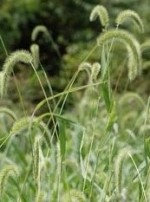 Giant foxtail was introduced into North America from East Asia in the 1930s and is now a common weed in the eastern half of the United States especially in the corn belt where is significantly reduces crop yields. It is uncommon in the western United States but has been a problem in some areas of California. Giant foxtail grass prefers full sun and moist to dry, fertile sandy soil high in nitrogen and phosphorus but tolerates less. It prefers disturbed sites such as croplands, gardens, fields, pastures, roadsides, vacant lots, and construction sites. Although it tolerates compacted soil it is not usually a problem in lawns because it can’t tolerate mowing.
Giant foxtail was introduced into North America from East Asia in the 1930s and is now a common weed in the eastern half of the United States especially in the corn belt where is significantly reduces crop yields. It is uncommon in the western United States but has been a problem in some areas of California. Giant foxtail grass prefers full sun and moist to dry, fertile sandy soil high in nitrogen and phosphorus but tolerates less. It prefers disturbed sites such as croplands, gardens, fields, pastures, roadsides, vacant lots, and construction sites. Although it tolerates compacted soil it is not usually a problem in lawns because it can’t tolerate mowing.
 Description: Giant foxtail is a summer annual that sprouts from early spring to midsummer when the soil is warm sending up erect multiple stems that are often branched at their base and grow 2 to 7 feet tall. The light green floppy leaves are up to 15” long and bear small hairs over their entire upper surface, one of the characteristics that distinguish it from other common foxtail grasses. From midsummer to fall spike-like panicles are produced at the ends of the stems and are up to 7 inches long. They nod downward and have long bristles that give the spike the look of a fox’s tail. The bristles are green at first but become light brown as they mature. The green spikes are especially attractive in dried flower arrangements. An abundance of small, pale seeds are produced that are very appealing to birds. The seeds can remain in the soil for 5 years. The root system is shallow and fibrous.
Description: Giant foxtail is a summer annual that sprouts from early spring to midsummer when the soil is warm sending up erect multiple stems that are often branched at their base and grow 2 to 7 feet tall. The light green floppy leaves are up to 15” long and bear small hairs over their entire upper surface, one of the characteristics that distinguish it from other common foxtail grasses. From midsummer to fall spike-like panicles are produced at the ends of the stems and are up to 7 inches long. They nod downward and have long bristles that give the spike the look of a fox’s tail. The bristles are green at first but become light brown as they mature. The green spikes are especially attractive in dried flower arrangements. An abundance of small, pale seeds are produced that are very appealing to birds. The seeds can remain in the soil for 5 years. The root system is shallow and fibrous.
Giant foxtail is similar in appearance to green foxtail and yellow foxtail. They can be distinguished on the basis of size, color of immature flowerheads, and leaf hairiness. As the name implies, giant foxtail is usually larger than the other two; it also has longer flowerheads and they are curved rather than straight. In addition, giant foxtail has hairs on the leaves that the other two foxtails lack.

 Control: Preventing the introduction of this weed seeds into the garden is the first line of defense. Seeds can pass through the digestive tracts of animals unharmed so careful selection of manure is advised. Carefully clean equipment that has been used in infested areas before using in uninfected areas to remove unwanted seeds. Once plants are growing in the garden, hand pull or hoe them, preferably when the soil is wet. Use mulch or a cover-crop to reduce germination of seeds and growth of seedlings. If possible, mow plants before they set seed as giant foxtail does not tolerate mowing. Herbicides can offer control with pre-emergent herbicides providing the best results.
Control: Preventing the introduction of this weed seeds into the garden is the first line of defense. Seeds can pass through the digestive tracts of animals unharmed so careful selection of manure is advised. Carefully clean equipment that has been used in infested areas before using in uninfected areas to remove unwanted seeds. Once plants are growing in the garden, hand pull or hoe them, preferably when the soil is wet. Use mulch or a cover-crop to reduce germination of seeds and growth of seedlings. If possible, mow plants before they set seed as giant foxtail does not tolerate mowing. Herbicides can offer control with pre-emergent herbicides providing the best results.